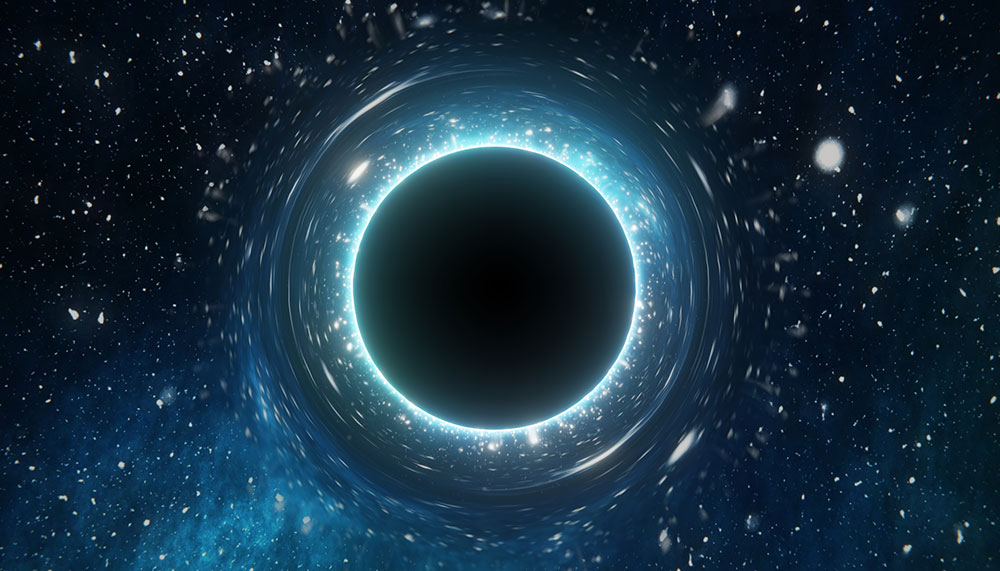The Dark Side of the Universe: How Black Holes Became Supermassive
New model from Brookhaven Lab physicists suggests the early universe experienced a phase transition that formed supermassive black holes in a dark sector of physics
March 11, 2022
Black holes are one of the most compelling mysteries of the universe. Nothing, not even light, can escape a black hole. And at the center of nearly every galaxy there is a supermassive black hole that’s millions to billions of times more massive than the sun. Understanding black holes, and how they become supermassive, could shed light on the evolution of the universe.
Three physicists at the U.S. Department of Energy’s (DOE) Brookhaven National Laboratory have recently developed a model to explain the formation of supermassive black holes, as well as the nature of another phenomenon: dark matter. In a paper published in Physical Review Letters, theoretical physicists Hooman Davoudiasl, Peter Denton, and Julia Gehrlein describe a cosmological phase transition that facilitated the formation of supermassive black holes in a dark sector of the universe.
A cosmological phase transition is akin to a more familiar type of phase transition: bringing water to a boil. When water reaches the exact right temperature, it erupts into bubbles and vapor. Imagine that process taking place with a primordial state of matter. Then, shift the process in reverse so it has a cooling effect and magnify it to the scale of the universe.
“Before galaxies existed, the universe was hot and dense, and that is well established. How the universe cooled down to what we observe today is a matter of interest because we don’t have experimental data describing how that happened,” said Peter Denton. “We can predict what happened with the known particles because they interact often. But what if there are not-yet-known particles out there performing differently?”
To explore this question, the Brookhaven team developed a model for a dark sector of the universe, where yet-to-be-discovered particles abound and rarely interact. Among these particles could be ultralight dark matter, predicted to be 28 orders of magnitude lighter than a proton. Dark matter has never been directly observed, but physicists believe it makes up most of the universe’s matter based on its gravitational effects.
“The frequency of interactions between known particles suggests matter, as we know it, would not have collapsed into black holes very efficiently,” Denton said. “But, if there was a dark sector with ultralight dark matter, the early universe might have had just the right conditions for a very efficient form of collapse.”
Recent observations have suggested supermassive black holes formed in the early universe, much earlier than physicists previously thought. This finding leaves little time to account for the growth of supermassive black holes. Physicists know that black holes acquire mass primarily by two means. One way, called accretion, is when matter, mostly dust, falls into black holes. But there’s a limit to the speed by which matter can accumulate in black holes through accretion. The second way is through galactic collisions, during which two black holes can merge; however, in the early universe, galaxies were just starting to form. So, physicists have been left wondering how these ancient cosmological wonders grew so massive so quickly. Ultralight dark matter particles could be the missing piece.
“We theorized how particles in the dark sector could undergo a phase transition that enables matter to very efficiently collapse into black holes,” Denton said. “When the temperature of the universe is just right, the pressure can suddenly drop to a very low level, allowing gravity to take over and matter to collapse. Our understanding of known particles indicates that this process wouldn't normally happen.”
Such a phase transition would be a dramatic event, even for something as spectacular as the universe.
“These collapses are a big deal. They emit gravitational waves,” Denton said. “Those waves have a characteristic shape, so we make a prediction for that signal and its expected frequency range.”
Current gravitational wave experiments aren’t sensitive enough to validate the theory, but next-generation experiments may be able to detect signals of those waves. And based on the waves’ characteristic shape, physicists could then narrow in on the details of supermassive black hole formation. Until then, Brookhaven theorists will continue to evaluate new data and refine their model.
This work was supported by the DOE Office of Science.
Brookhaven National Laboratory is supported by the Office of Science of the U.S. Department of Energy. The Office of Science is the single largest supporter of basic research in the physical sciences in the United States and is working to address some of the most pressing challenges of our time. For more information, please visit science.energy.gov.
Follow @BrookhavenLab on Twitter or find us on Facebook.
2022-19425 | INT/EXT | Newsroom










